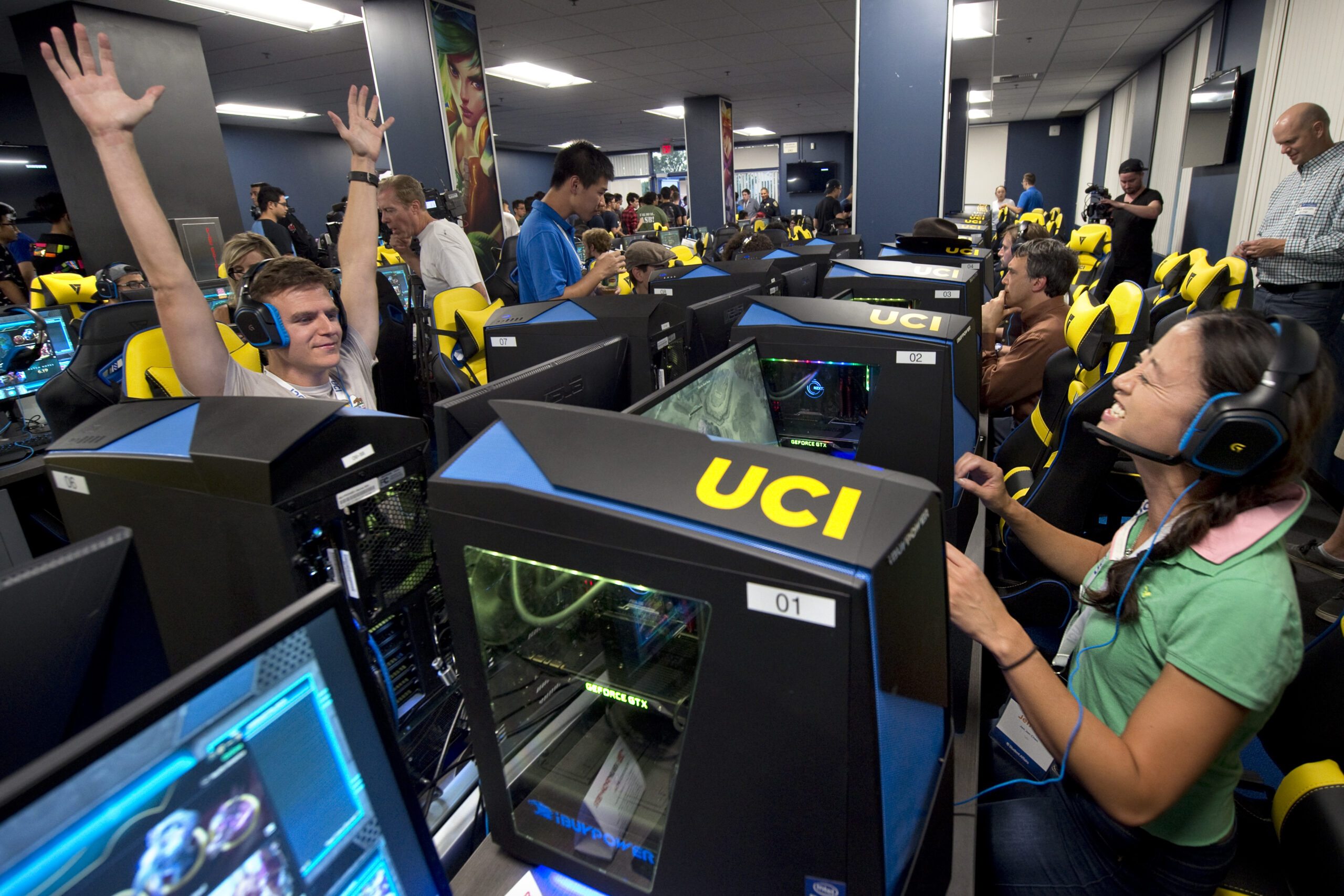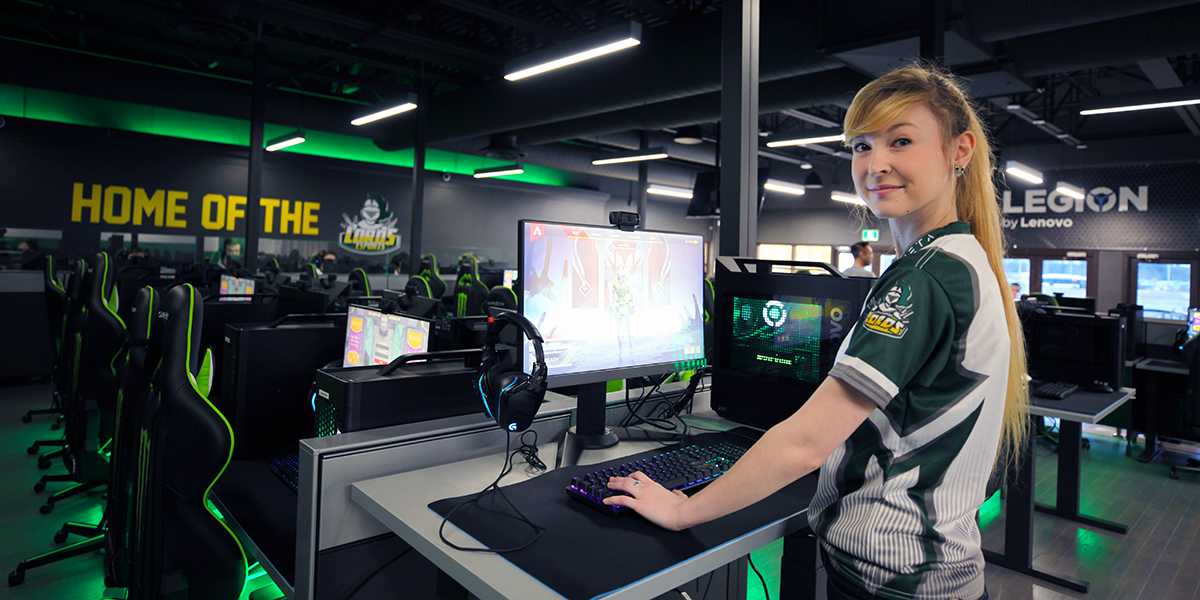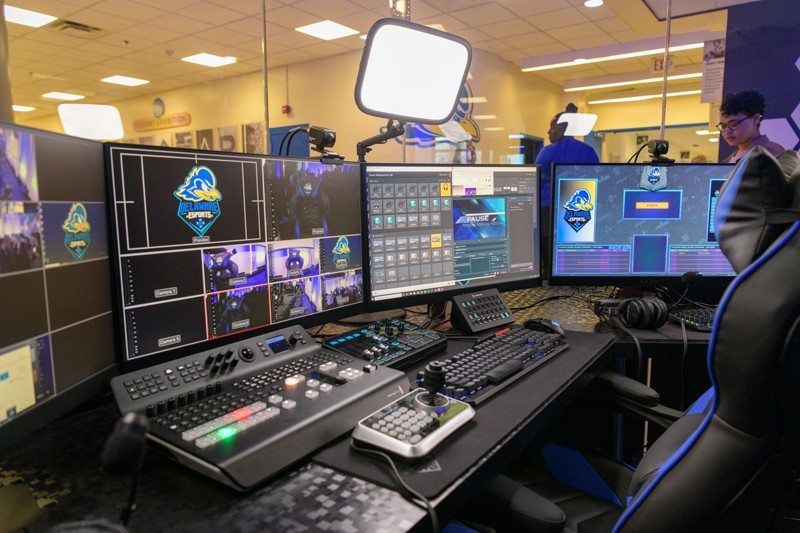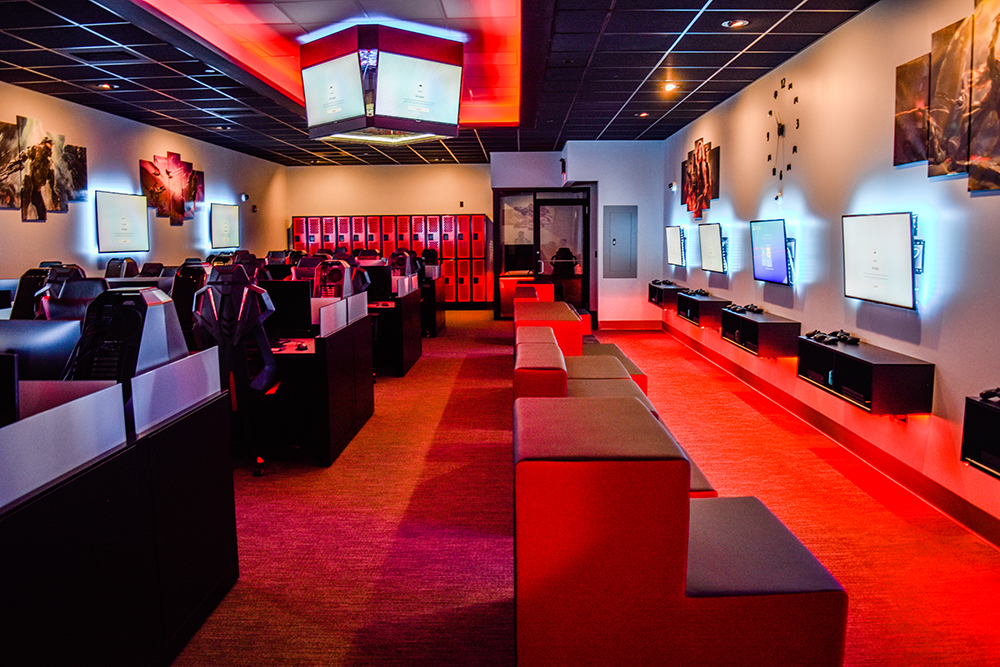If your college or university is thinking about launching an esports program or simply looking for more space for one, there is a long checklist of items to consider – from equipment to staffing to actual game play. One of the most important elements, of course, is finding a dedicated place on your campus. Some colleges simply choose to house their program in converted classrooms, while others overhaul much larger, open areas to serve students. University Business will periodically offer up some dynamic collegiate esports facilities that are not only high on design but also incredibly functional, from the smallest to the largest (watch for our next set coming soon!)
UNIVERSITY OF DELAWARE
This 1,800-square-foot gamers’ paradise, which opened in February in the Perkins Student Center, is jaw-dropping and dripping with the some of the best bling of any campus in the country. In addition to its glass-enclosed broadcasting booth, it has an elevated stage with 50-inch monitors and a powerful, 2,000-watt sound systems and subwoofers. The real showpiece is its hexagon-weave wall that features changing, projected images of varsity members on different panels.
“We’ve got digital signage; we can broadcast live matches to all 20 screens across our student centers,” says Tony Doody, Director of University Centers. “So they are becoming celebrities, probably moreso than our traditional athletes. During peak times, every computer is used. Our software is fantastic.”
The space is for students at UD, not just for Blue Hens esports teams, and it’s free for all to use. It offers 25 game titles, 33 HP Omen computers and nine console gaming setups. Scott Payette Architects, Josh Kell and the team at Horizon AVL and Esports Integration thought of everything here, including a scent machine, laser projectors and arena-style scoreboard. UD matches are streamed live from the arena. But the biggest stroke of genius was Scott Payette Architects’ solution for the facility’s HVAC units they housed them in Super Mario Bros.-style green tubes.
CENTRAL MAINE COMMUNITY COLLEGE
Those outside of New England may not have heard of this small Southern Maine school that serves 2,700 students, many of whom enjoy one of the lowest tuition rates of any institution ($3,271). But it certainly has raised eyebrows in the esports community by not only offering an Esports Management associate’s degree but by also having its esports teams compete in NACE against four-year colleges. The Mustangs, in fact, sent two teams to the postseason in the ECAC last season.
More impressive than the fact that this community college has its own arena (very few do), is that it is amazing. The 1,600-square-foot room in Kirk Hall features rows of Alienware Area 51 Threadripper gaming desktops, five small console areas, a broadcast booth and a striking, Zen-like design, highlighted by esports wall art, splashes of red throughout, as well as lockers and step sofas.
“We created the space thinking beyond gaming,” says Andrew Morong, Director of Admissions. “We wanted it to be a recruiting centerpiece of the institution because we knew no one else in Maine or New England would have this. In an economy that was not supposed to be favorable to community colleges, we knew we needed to diversify our offerings to stay ahead of the game.”
UNIVERSITY OF CALIFORNIA, IRVINE

One of the top esports programs in the country is backed by one of the nation’s best research universities. Cal-Irvine created the first public college esports arena in 2016 and it is one that is still being emulated by many schools. At 3,500 square feet, the UCI Esports Arena is a multi-purpose space that not only houses its competitive teams but also serves other UCI students and the local community.
The original space wasn’t getting much use with a few pool tables and consoles games, so UCI did a completely refurbishment. How did UCI manage to build all of it? Mostly through a slew of sponsorship deals.
“We redid the carpet, we repainted everything, we added a bunch of cabling,” says Kathy Chiang, Assistant Director of UCI Esports. “We had really great computers just right out the door. We wanted to show off top-of-the-line equipment that encouraged people to want to come in here instead of play at home.”
The arena is open from noon to midnight and offers a variety of games, including the best current titles to old-school hits such as StarCraft. There are console games, a broadcast station for streaming and shoutcasting and VR setups from time to time. But what makes this area so special is its connection to the university’s research arm and courses that are geared toward esports. It’s tight but still cool and soon to get some breathing room there is another space coming for its esports team soon.
OHIO STATE UNIVERSITY

Across its 1,600-plus acres in Columbus, Ohio State is “building the campus of the future.” That includes projects like an Arts District, as well as a Health Center and Research Facility. OSU recently did a $7.8 million upgrade to its already posh Woody Hayes Athletic Center. Innovation is happening everywhere, including revamps of older buildings such as Lincoln Tower. Once a full residence hall, Lincoln Tower is now home to offices and dorms but also to one of its latest, greatest spaces: its esports facility.
Brandon Smith, Esports Director and Enterprise Project Lead, and his team spent nearly two years from initial planning stages to developing an imaginative, practical and fun area for gamers. The mission was to blend that environment of education with community engagement, with a place of belonging for some students. The reality has been more than they could have dreamed. OSU has 80 workstations (18 are reserved for esports players), Nintendo Switches, Playstations and Xbox consoles, plus one surprise area of interest: virtual reality. In its first six months, it hosted 2,000 unique students, including 35% that are international students. One of the biggest challenges for Smith was the footprint.
“It is a contiguous space,” Smith says. “It didn’t make sense to subdivide it. We’re in a hexagonal building with lots of building supports running through it. Between our interior designer and our architects, everyone did a great job of piecing together every usable space we could find.”
DURHAM COLLEGE

Canada is crazy about esports, and its premier campus space to game is at Durham College in Oshawa, Ontario. Opened a year ago, there are more than 50 workstations plus consoles, and more than 50 games for Lords team members, alumni and employees to play.
When it was opened a year ago, Durham president Don Lovisa touted it as a “living lab” and arena manager Sarah Wagg called it a “gamers’ paradise.” Indeed, this 3,000-square-foot hub boasts DX Racer chairs, PCs with Nvidia GEForce RTX 2080 graphics cards and five 55-inch monitors and a 110-inch projector for tournament broadcasts. Twelve of the varsity team’s stations sit behind glass partitions that separate players from spectators.
The brainchild of professor and esports coordinator Michael Cameron, this space located in the Student Centre came about after a simple conversation of what was possible back in 2016. Open to innovation – Durham is one of the Canada’s top 50 research colleges – it embraced the idea, and various stakeholders across campus met weekly to discuss options, IT and facilities needs and finances. Most importantly, they found a strong logistics presence on campus, Bart Lucyk, to help bring the project to life.
The space is stunning, containing lounge-style seating and a fireplace. And it isn’t just a gaming space but also an avenue to expand experiential learning for full-time programs.
Chris Burt is the Esports Editor and Program Chair for the Academic Esports Conference & Expo. He can be reached at [email protected]



